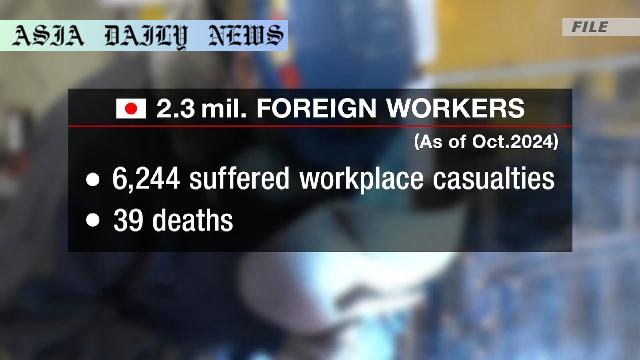Workplace Accidents: Japanese government survey reveals over 6,000 foreign workers were injured or died in workplace mishaps in 2024.
Over 6,000 foreign workers in Japan were injured or killed in 2024 workplace accidents.
The casualty rate for foreign workers is higher than the overall population, standing at 2.71 per 1,000.
The Labor Ministry identified lack of experience and language barriers as major factors.
Most affected industries include manufacturing, construction, and commerce.
Workers from Vietnam, the Philippines, and Indonesia are among the most impacted.

Introduction: A Grim Reality Unfolds
A recent survey conducted by the Japanese government has brought to light an alarming trend – over 6,000 foreign workers were injured or lost their lives in workplace accidents across Japan in 2024 alone. This grim statistic marks not only an increase of 572 cases from the previous year but also the 13th consecutive year of such growth. The rising casualty rate among foreign workers highlights systemic challenges, including language barriers and insufficient vocational training, raising concerns about workplace safety and inclusivity in one of the world’s most developed economies.
Statistical Insights: Breaking Down the Numbers
The Labor Ministry’s data reveals that the casualty rate for foreign workers stands at 2.71 per 1,000, higher than the national average of 2.3 per 1,000 for all employees, including Japanese nationals. Within the foreign workforce itself, technical interns appear to face the greatest risks, with a casualty rate of 3.98 per 1,000, surpassing their counterparts holding special skilled worker status, who experience a slightly lower rate of 3.91 per 1,000. Key industries such as manufacturing, construction, and commerce accounted for most of these incidents, with manufacturing topping the list at 2,979 affected workers. This underscores the growing need for enhanced safety protocols in such high-risk environments.
Country-Specific Data: Foreign Workers at the Forefront
The statistics also reveal a disproportionate impact on workers from certain countries and regions. Vietnam tops the list, with 1,594 affected workers, followed by the Philippines with 878, and Indonesia with 757. Many of these workers are employed as technical interns or under special skilled worker status, programs designed to address labor shortages in Japan. However, the high casualty rates among these groups suggest that the current systems may not provide adequate safeguards or training to ensure their safety on the job.
Factors Behind the Rising Casualties
The Japanese Labor Ministry has attributed the increasing number of workplace fatalities and injuries to factors such as language barriers, lack of vocational experience, and inadequate comprehension of workplace risks. For many foreign workers, especially those from non-Japanese speaking countries, understanding safety protocols becomes a challenge, despite the availability of translated materials. This lack of effective communication exacerbates their vulnerability to accidents at work.
Recommendations for Improvement
In response to this alarming trend, the Labor Ministry has urged companies to intensify their focus on worker safety. Specifically, businesses are encouraged to provide thorough safety training programs and use educational materials tailored to foreign workers. By addressing the language barrier and cultural nuances, these measures aim to mitigate the risks faced by foreign nationals in Japanese workplaces. Furthermore, a structured mentorship or buddy system could further assist foreign workers in acclimating to workplace environments, ensuring their safety and well-being.
Conclusion: A Call for Action
The rise in workplace accidents involving foreign workers in Japan reflects an urgent need for systemic changes. While the country continues to rely heavily on foreign labor to sustain vital industries, their safety and well-being must be prioritized. Policymakers, employers, and society at large must collaborate to create safer, more inclusive workplaces. By addressing the root causes, such as language barriers and insufficient training, Japan can not only improve its workplace safety statistics but also foster a more harmonious and sustainable work environment for all.



Commentary
Examining the Systemic Issues
The steady rise in workplace accidents among foreign workers in Japan paints a concerning picture of the systemic challenges these individuals face. Language barriers stand out as a critical hurdle, preventing workers from fully understanding safety protocols and workplace risks. This issue is compounded by the lack of adequate vocational training tailored to foreign nationals. For a country that increasingly relies on foreign labor to sustain its industries, these shortcomings emphasize the pressing need for reforms in workplace policies and employer responsibilities.
Focus on High-Risk Industries
Manufacturing and construction industries dominate the casualty statistics, suggesting that these sectors require immediate safety interventions. Employers in these fields must adopt proactive measures, such as employing multilingual trainers or creating visual safety guides, to ensure that foreign workers comprehend and adhere to safety guidelines. Additionally, the introduction of regular safety drills and mentorship schemes can significantly reduce the likelihood of accidents, especially among inexperienced technical interns.
A Path Toward Inclusive Growth
Japan’s reliance on foreign workers is bound to grow as its labor shortage intensifies. Thus, fostering an inclusive workplace culture where safety is prioritized for all employees, regardless of nationality, is crucial. Policymakers and regulators must work hand-in-hand with employers to implement comprehensive safety measures and hold companies accountable for the well-being of their workers. As Japan navigates this demographic shift, creating safer workplaces can serve as a benchmark for other nations grappling with similar challenges.